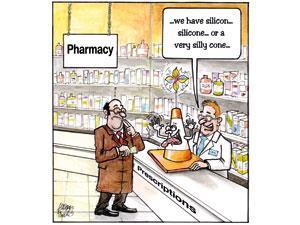Philip Ball has sympathy for those nonplussed by nomenclature
In his new novel, The Chemistry of Tears, author Peter Carey displays his deep interest in science. The book alludes to the mechanical inventiveness that sustained the Industrial Revolution, and makes much reference to Charles Babbage’s proto-computer – the difference engine – and to modern scientific analysis of historical artifacts. (The chemistry of tears is given a fleeting nod too.) Having met Carey recently, I know how keen he is to get the science correct. So I hope he won’t be too mortified to discover that he has used ‘silicon’ when he clearly meant ‘silicone’.
But I did not note this with a thrill of superiority. On the contrary, I felt cross on Carey’s behalf. For what could be more unhelpful and confusing than giving a chemical compound a name that is all but indistinguishable from a chemical element? This has long topped my list of bad chemical names. It’s not even as though there is a good excuse. When Frederick Kipping, an excellent synthetic chemist at the University of Nottingham, UK, began making organosilicon compounds around the turn of the century, he was keen to develop an analogy between carbon compounds and what seemed to be their silicon analogues. For that reason, he called the long-chain diphenylsiloxane, Ph2SiO, a ‘silicone’ because its molecular formula was analogous to that of the ketone benzophenone, Ph2CO. Although it was clear even then that the silicon compound was polymeric and bore no chemical similarity to ketones,1 this predilection lumbered us with Kipping’s confounding name.
Name calling
It’s not hard to find other examples, and drugs are some of the worst offenders. This, however, is a tough one. There are so many to name, and you don’t want them to be totally arbitrary. But do they have to be quite so un-euphonious? I don’t hold out any prospect that my wife will ever pronounce ibuprofen properly, and the only reason I do so is that I have acquired the chemist’s pedantry for complex nomenclature. I know that the chemical reasoning here is sounder: it is a contraction of isobutyl propanoic phenolic acid. But it makes you wonder whether some people still get their analgesia from aspirin simply because they can pronounce it in the pharmacist’s.
Other generic drug names are even worse: clopidogrel, lansoprazole, bevacizumab, venlafaxine. And the brand names are hardly masterful neologisms, sounding more like characters in bad science fiction, but at least they tend to roll off the tongue: Crestor, Effexor, Valtrex. Of course, the Iupac names of these compounds are indigestible for the lay person, but they are never intended for lay use, and they are tightly constrained by their information content. For generic names, we do at least have some choice.
There is some method in the madness. A drug’s generic (or ‘international nonproprietary’) name is ultimately fixed by the World Health Organization, but many are first prescribed by the US Adopted Names (USAN) Council, which has its own guidelines. In particular, the stem of the name denotes the effect or mode of action: -axine drugs are antidepressants that inhibit uptake of particular neurotransmitters, -vir means an antiviral, -mab is a monoclonal antibody, and so on. Some prefixes and other syllables have particular meanings – lev- and dex- are clearly stereoisomers – but most don’t. The USAN Council aims to avoid names that non-English speakers will find hard to pronounce, as well as ones that turn out to have obscene connotations in other languages, so there are no equivalents of the wonderful arsole.
Taxology

Despite this logic, is it really just familiarity that separates codeine and paracetamol from atorvastatin and montelukast? Faced with these agglomerations of semi-arbitrary syllables, one has to wonder if half a system is worse than no system at all. The proliferation of brand names only makes matters worse; I had no idea until I looked that Taxol is also known as Onxol, Abraxane and Cryoxet. I shouldn’t even call it Taxol, of course, since Bristol-Myers Squibb got very upset when its brand name was used instead of the generic paclitaxel. While plenty of brand names have become common through familiarity (eg Kevlar), this was the reverse: Taxol was widely used by chemists before Bristol-Myers Squibb registered it as a trademark, provoking dismay at their appropriation of established usage.2
Whatever the legal issues, the fact is that Taxol works as a name: anyone can say it without effort and not confuse it with something else. With graphene, fullerenes and dendrimers, scientists have shown that they can sometimes master the trick of balancing euphony, descriptiveness and specificity in chemical naming. But there’s still cause for entreating that, before you christen your compound, think how it will sound in Boots.
Philip Ball is a science writer based in London, UK
References
- K L Mittal and A Pizzi (eds), Handbook of Sealant Technology, 2009, 13, CRC Press
- N White and S Cohen, Nature, 1995, 375, 432












No comments yet